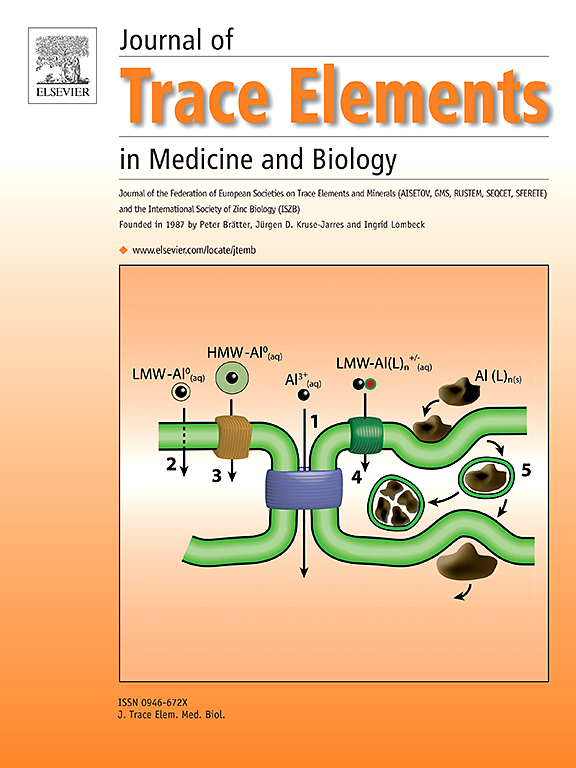Synthesis, crystal structure, characterization and antimicrobial activities of ternary chiral mononuclear Schiff base copper(II) complexes
IF 3.6
3区 医学
Q2 BIOCHEMISTRY & MOLECULAR BIOLOGY
Journal of Trace Elements in Medicine and Biology
Pub Date : 2025-01-10
DOI:10.1016/j.jtemb.2025.127590
引用次数: 0
Abstract
[CuL1–4(tmen)] is a sequence of four ternary mononuclear Schiff base copper(II) complexes that are derived from L-valine, suitable 5′-substituted-2′-hydroxyacetophenones (where the substituents are -Cl for L1, -Me for L2, -OMe for L3, and -H for L4), and tmen (where tmen-N,N,N′,N′ tetramethyl ethylenediamine). Without isolating the Schiff base ligand or producing any other intermediate products, all of the complexes were synthesised. These compounds were identified using elemental analysis, molar conductance, UV-Vis, FTIR, EPR, VSM-RT, and CD spectra. Single crystal XRD was used to characterise the structure of Complex 1. The crystalline structure exhibits a distorted square pyramidal shape wherein the Schiff base forms an axial bond with the Cu(II) ion through the ONO-donor, while the chelating ligand tmen exhibits both an equatorial and an axial mode of binding through the NN-donor atoms. Hydrogen bonding and non-covalent CH(methyl)![]() π(phenyl) interaction are two intriguing aspects of compound 1's packing diagram. By calculating the minimum inhibitory concentration (MIC) against harmful bacteria, the synthesised complexes' antimicrobial activity was assessed. According to the bioactivity experiments, the microorganisms employed in this investigation were susceptible to the antibacterial and antifungal properties of copper(II) complexes 1–4. According to the bioactivity experiments, the microorganisms employed in this investigation were susceptible to the antibacterial and antifungal properties of copper(II) complexes 1–4.
π(phenyl) interaction are two intriguing aspects of compound 1's packing diagram. By calculating the minimum inhibitory concentration (MIC) against harmful bacteria, the synthesised complexes' antimicrobial activity was assessed. According to the bioactivity experiments, the microorganisms employed in this investigation were susceptible to the antibacterial and antifungal properties of copper(II) complexes 1–4. According to the bioactivity experiments, the microorganisms employed in this investigation were susceptible to the antibacterial and antifungal properties of copper(II) complexes 1–4.
三手性单核席夫碱铜(II)配合物的合成、晶体结构、表征及抗菌活性。
[CuL1-4(tmen)]是由L-valine,合适的5'-取代-2'-羟基苯乙酮(其中取代基为-Cl - L1, -Me - L2, -OMe - L3和-H - L4)和tmen(其中tmen-N,N,N‘,N’四甲基乙二胺)衍生的四个三元单核希夫碱铜(II)配合物序列。在没有分离希夫碱配体或产生任何其他中间产物的情况下,所有配合物都被合成。通过元素分析、摩尔电导、UV-Vis、FTIR、EPR、VSM-RT和CD光谱对这些化合物进行了鉴定。采用单晶XRD对配合物1的结构进行表征。晶体结构呈扭曲的方锥体形状,其中席夫碱通过ono给体与Cu(II)离子形成轴向键,而螯合配体则通过n -给体原子形成赤道键和轴向键。氢键和非共价CH(甲基)π(苯基)相互作用是化合物1的填料图中两个有趣的方面。通过计算对有害细菌的最小抑制浓度(MIC),对合成的配合物的抗菌活性进行了评估。根据生物活性实验,本研究中使用的微生物对铜(II)配合物1-4的抗菌和抗真菌性能敏感。根据生物活性实验,本研究中使用的微生物对铜(II)配合物1-4的抗菌和抗真菌性能敏感。
本文章由计算机程序翻译,如有差异,请以英文原文为准。
求助全文
约1分钟内获得全文
求助全文
来源期刊
CiteScore
6.60
自引率
2.90%
发文量
202
审稿时长
85 days
期刊介绍:
The journal provides the reader with a thorough description of theoretical and applied aspects of trace elements in medicine and biology and is devoted to the advancement of scientific knowledge about trace elements and trace element species. Trace elements play essential roles in the maintenance of physiological processes. During the last decades there has been a great deal of scientific investigation about the function and binding of trace elements. The Journal of Trace Elements in Medicine and Biology focuses on the description and dissemination of scientific results concerning the role of trace elements with respect to their mode of action in health and disease and nutritional importance. Progress in the knowledge of the biological role of trace elements depends, however, on advances in trace elements chemistry. Thus the Journal of Trace Elements in Medicine and Biology will include only those papers that base their results on proven analytical methods.
Also, we only publish those articles in which the quality assurance regarding the execution of experiments and achievement of results is guaranteed.

 求助内容:
求助内容: 应助结果提醒方式:
应助结果提醒方式:


